How to drain condensation from a household gas cylinder: nuances of condensation formation + instructions for draining
Does each refill of your gas cylinder last for a shorter period of time? Or maybe you noticed a deterioration in the quality of the flame - the burner puffs and goes out from time to time? The reason for this may be condensation that has accumulated in the cylinder after many refills. If you drain it and pump in high-quality gas at a specialized gas station, gas appliances from the cylinder will begin to work no worse than from the central gas pipeline: stably, smoothly and without soot.
In this article we will figure out what gas condensate is, where it comes from in the cylinder, whether it is necessary to get rid of it, and, most importantly, how to drain the condensate from a household gas cylinder yourself.
The content of the article:
What condenses in a gas cylinder?
You can often notice that the gas in the cylinder has run out, but something continues to splash at the bottom. Some think it's a little longer liquefied gas, it just doesn't come out and light up for some reason, but that's not the case. In fact, after using all the gas in the cylinder, there remains condensate - a residue that does not go into a gaseous state at room temperature, and therefore does not come out under pressure and does not provide combustion.
To understand why condensation forms in your gas cylinder, let's understand what it consists of.
The liquid that remains at the bottom of the cylinder after all the gas has been used usually consists of several components.
Among them may be:
- Gasoline - non-volatile petroleum products, something between butane and gasoline.
- Odorant – gas flavoring.
- Non-flammable impurities – not uncommon when using insufficiently purified gas or refueling from a practically empty tank.
- Water - the rarest, but also the most dangerous component in this case.
- Butane – if the cylinder was used in the cold.
The amount of such impurities present in the propane-butane mixture and forming condensate directly depends on the quality of the cylinder filling, as well as on the time of year.
Propane at normal pressure turns into gas at a temperature of -30 degrees, and butane - at 1 degree below zero.
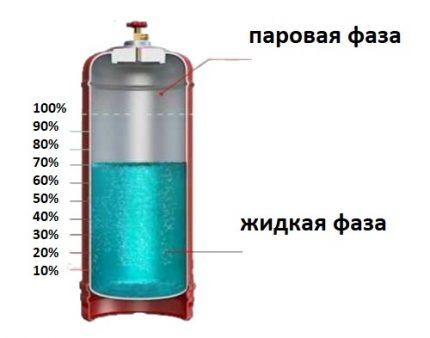
However, there are other petroleum products whose boiling point is much higher: +30 - +90 degrees and higher. That is, when heated to a sufficient temperature, they will behave in the same way as propane and butane - but heating a gas cylinder is very dangerous. And at room temperature, and even at increased pressure inside the cylinder, they remain in a liquid state, forming condensate.
These non-volatile fractions under normal conditions are called gasoline, and the higher the quality of the gas at the gas station, the lower the percentage of their content.
In addition to gasoline, the propane-butane technical mixture that is used to fill household gas cylinders always contains an odorant. This is a special substance, ethyl mercoptane, with an extremely strong pungent odor: it is added in order to notice a leak in time and have time to prevent the accumulation of gas in the room.In addition to the smell of the odorant, you can promptly detect a gas leak and analyze the composition of the gas mixture using special equipment - gas analyzer.
Without the addition of an odorant, the gas mixture would have no odor - just as neither purified propane, nor pure butane, nor natural gas have any odor. The odorant is also non-flammable, so it remains in the condensate. Its volume is negligible, because according to the norms, 6–9 ml of flavoring is added per 100 kg of liquefied gas. However, after using the cylinder, it almost completely remains in the condensate, due to the decrease in the total mass of substances, its concentration increases.
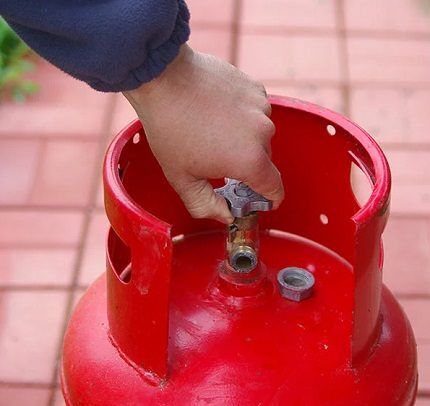
There should normally be no water or non-flammable impurities in the gas. However, when refueling at untested stations, anything can happen, so we named these components of condensate. Water in a gas cylinder is dangerous because it provokes corrosion of the inner surface of the metal. The inside of the cylinder is not painted, and therefore it rusts easily, and it is impossible to control this process. Such rust is discovered only when it eats through the metal - and this is already too late and extremely dangerous.
Butane is added to household gas cylinders in smaller quantities than propane: in summer their ratio is about 2:3, and in winter – at least 2:8. This is only subject to refueling at a specialized station, and not with automobile gas. As we already mentioned, butane, unlike propane, does not turn into gas at subzero temperatures, so a cylinder installed outdoors may run out sooner than expected.
If you used bottled gas in late autumn or winter, especially if it was filled in the summer, try bringing the bottle indoors after the gas stops supplying. Most likely, after its contents have warmed to room temperature, you will be able to use it for some time.
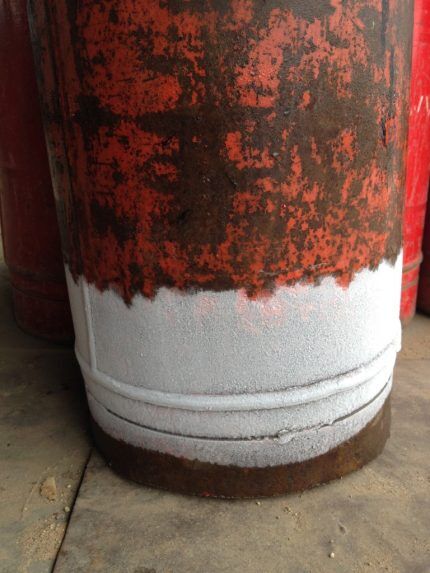
There is no need to do anything with condensation or frost on the outside of the cylinder; this moisture can only harm the container on which the paint layer is damaged: with prolonged and regular exposure, the steel of the cylinder can begin to rust, and corrosion can lead to leakage, fire and even gas cylinder explosion.
However, this will take quite a lot of time, so the user’s task is limited to maintaining uniform and high-quality coloring.
Frequency of draining condensate from the cylinder
But when should condensate be drained? This question is very individual and depends on the quality of the gas being filled and operating conditions.

Many users of gas cylinders have not encountered this need at all, while others do this before each refueling. Both of these extremes are normal behavior under certain conditions, and to determine which is closer to you, let’s look at these conditions in more detail.
Option #1 - refueling at a specialized substation
If you fill the cylinder at a specialized substation, you may not encounter condensate at all, for several reasons.Firstly, they fill with the “correct” gas, with a high content of propane, and not just cheap butane, as at car gas stations.
Secondly, their gas quality control is much stricter, so the degree of gas purification is higher, and there are practically no foreign impurities.
Thirdly, at most of these substations, cylinders are exchanged, and before refueling they are inspected and serviced, excessively worn ones are rejected, and after refueling, safety and tightness control is carried out. In particular, substation workers drain condensate if it has accumulated in the cylinder.
Even if you insist on refilling your particular cylinder, it will not be done without first making sure that the unit is in working order and safe. The fact is that specialized substations operate officially, observing standards and technical requirements when refilling cylinders, are responsible for the safety of each client.
Option #2 - refueling at a gas station
Cylinders filled at gas stations, but used for domestic purposes, are much more prone to condensation.
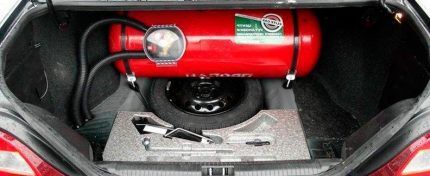
If the balloon filled at a gas station, put it at home, all impurities and slightly volatile gases will settle at the bottom and remain there in the form of condensate. Therefore, when refueling with automobile gas, the condensate must be drained at least every 3–4 refuelings, and better before each one.
Separately, we can mention small tourist gas cartridges, up to 1 liter in volume.They have a different outlet, reminiscent of a lighter refill can, and doing anything with it yourself other than using it for its intended purpose is difficult and unsafe. However, many craftsmen refill the cans with your own hands.
Although, in principle, it is more convenient and simpler when such cartridges are filled only at specialized points, with gas of the correct composition and a high degree of purification, so condensation does not form in them. And they are relatively inexpensive, and do not last for decades, like their larger counterparts, so when such a can starts to act up, they usually just buy a new one.
Instructions for draining condensate
If you neglect the procedure for draining the condensate, less and less gas will be placed in the cylinder each time, and it will not last as long. In addition, the bay is a normal amount gas mixture into a cylinderwhere condensation has already accumulated, you risk filling it to capacity, without leaving the required 15% void for the gas cushion. This is extremely dangerous and can cause the cylinder to rupture or explode at the slightest additional heat or shaking.
To prevent undesirable consequences, let's figure out together how to properly clean condensation from a household gas cylinder.
So, the first thing you need to do is use or release the remaining gas.
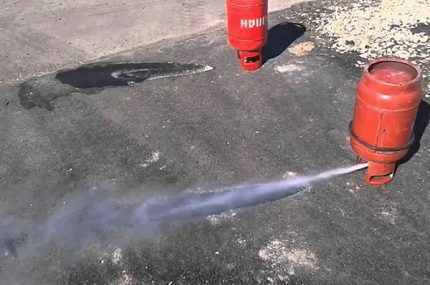
If the tile or other equipment is no longer working well from this cylinder and is chugging, you can simply release the gas on the street. To do this, remove gearbox and gradually open the valve.Under no circumstances do this near a house, fire, wiring, sparks, or in a confined space: a meadow or field where there are no people and the wind will quickly disperse the gas is ideal.
Violating this simple rule can lead to poisoning, fire or explosion - do not risk your health and those around you. Keep in mind that when a large amount of propane-butane passes from a liquid to a gaseous state, the remaining liquid cools down greatly and the cylinder becomes cold.
When the characteristic hissing sound stops when you open the tap, you can say that the gas has run out. That is, it remains only in a gaseous, and not liquid, state, exactly the same volume as the cylinder, so the pressure is not higher than atmospheric, and it does not come out. Most likely, even at this stage, something will splash around in the cylinder - this is condensation.
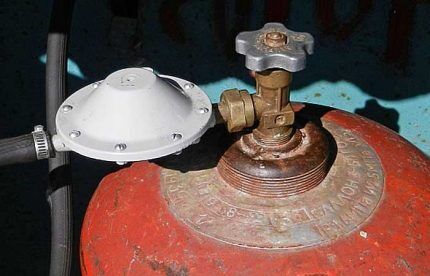
To get rid of condensation, do this:
- Choose a place remote from housing and fire hazards, preferably an unsown field and not the shore of a reservoir. A wasteland or wild meadow would be ideal. You cannot drain the condensate directly near the gas station where you are going to fill the cylinder.
- If the gearbox is still in place, remove it.
- It is advisable to prepare a glass or metal jar that can be tightly closed along with the drained substance.
- Open the tap and find the pipe underneath where the gearbox was attached.
- Turn the cylinder upside down, with this pipe facing away from you, directing it into the prepared container. For convenience, you can put a hose on it.
- If the liquid does not flow, or not all of it has drained, tilt and shake the container so that the last milliliters flow out.
- Be sure to close the valve so that the cylinder does not fill with air and moisture.
It is advisable that after this procedure nothing splashes in the balloon. Sometimes you can come across a recommendation to fry empty cylinders in the sun with the valves open in order to remove both remaining condensation and water that may have gotten into the cylinder. But this procedure can be unsafe, especially if you forget to open the valve, and an extra few milliliters of condensate will not make a difference, so it is better not to dry the cylinders unnecessarily.

With proper use, there is nowhere for water to come from, so you will not have to figure out how to properly drain water from a household gas cylinder, and drying is not required.
Safety rules when handling the cylinder
Gas cylinders are extremely dangerous. Every year, dozens and hundreds of household gas cylinders explode, destroying homes and killing people, and in most cases, violations are to blame rules of their operation.
When filling up gas legally, at a specialized substation, along with a full cylinder, you will receive a reminder on its safe transportation, storage and use. Among other things, it is prohibited to install cylinders closer than half a meter from a gas stove or a meter from a stove, heater or radiator.

You should not allow the cylinders to heat up - from any devices or in the sun - this can lead to their rupture. Also, they should not be stored in a tightly closed cabinet without ventilation at the bottom of the doors: in the event of a leak, the gas will fill the cabinet, and when combined with oxygen from the air, the mixture becomes extremely explosive. The slightest spark or electrical discharge is enough and there will be an explosion.
We also recommend that you read the article:Why do gas cylinders explode: the main causes of accidents.
You should not use a winter gas mixture with a high propane content in the summer: it will evaporate too actively, and the cylinder may swell or even burst from excess pressure - and this is with 3 mm thick steel walls.
It is also prohibited to use swollen, dented or damaged cylinders: there is no guarantee that it is sealed and will withstand gas pressure reaching 8 bar.
Conclusions and useful video on the topic
To make sure there are no questions left, we suggest watching a video about how condensate is drained from an empty cylinder:
When using gas cylinders at home, do not forget about the need for their maintenance, because this is a matter of your safety. Draining the condensate and checking the integrity yourself or entrusting it to professionals is up to you, and we told you how to do it effectively and safely.
Do you use gas cylinders and still have condensation after using the gas? Tell us how you get rid of it - the feedback form is located below.
If you have any questions or want to express your opinion about the advisability of draining condensate at home, please join the discussion on the topic.




I usually compress the air with a compressor before draining. Then I open the tap upside down, so it drains faster
Air is not possible, since water condensate is formed from the air.
The ass is shorter. The best way to get rid of this nasty thing is to light a pioneer fire and throw a balloon there. During the procedure, sit at least 3 meters away from the fire, otherwise when the fuck can hurt you with a piece of iron from the balloon